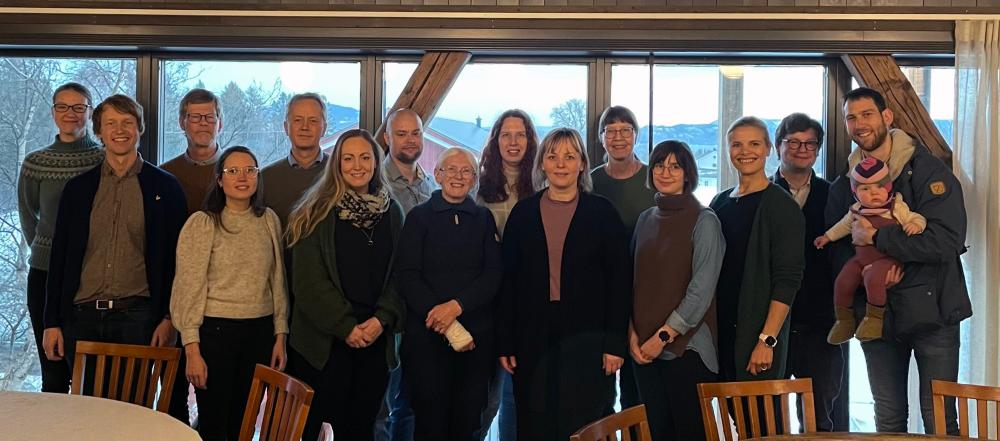TrønderBrain - Department of Neuroscience

The Trønderbrain project has been established in 2003 as a collaboration between the INB, NTNU and the Department of Neurology, St. Olavs Hospital to promote translational research on neurodegenerative diseases.
This heterogenous group of disorders is characterized by a progressive degeneration of brain structure and function. Common neurodegenerative diseases include Alzheimer’s disease (AD), Parkinson’s disease (PD), amyotrophic lateral sclerosis (ALS), and multiple sclerosis (MS). The risk of being affected increases dramatically with age. With a steady increase of life expectancy, neurodegenerative diseases have become one of the biggest global health concerns among elderly.
The research focus of Trønderbrain is to understand molecular processes that drive the initiation and progression of neurodegenerative diseases with special emphasis on AD. The overall goal is to identify novel biomarkers for early diagnosis and targets for effective therapy. To achieve this, we have brought together a team of clinicians and research scientists to build the bridge from basic research in cell and animal models to clinical research in humans.

Research participation
For our research we rely on volunteers that would like to participate in the project as healthy controls.
- Do you still remember well?
- Are between 50 and 80 years old?
- Are you willing to return for follow-up visits after 2, 4 and 10 years?
- Do you live in acceptable distance to St. Olavs Hospital?
Then, we ask you to carefully read the information about what your participation in our research would involve and get in contact with us.
Research Interest
Biomarkers for detection and monitoring of neurodegenerative diseases
Biomarkers for detection and monitoring of neurodegenerative diseases
Diagnosis of neurodegenerative diseases at an early stage still remains a challenge, thus methods to improve pre-symptomatic detection would provide opportunities for early intervention, treatment, and improved patient function.
We aim to identify novel biomarkers for neurodegenerative diseases by using advanced imaging technologies including 7T-MRI and PET-scanning as well as the promising liquid biopsy-based analysis of cell-free DNA and RNA. Further, investigating the underlying disease mechanisms will contribute to identify novel targets for diagnosis.
Understanding molecular mechanisms of neurodegenerative diseases
Understanding molecular mechanisms of neurodegenerative diseases
The underlying causes of neurodegenerative diseases are still mainly unknown. The pathogeneses are likely a result from complex interactions between genetic, epigenetic, and environmental factors preceding clinical manifestation of the diseases. Notably, no effective treatment to halt or reverse neurodegeneration is to date available. We aim to identify the molecular mechanisms underlying neurodegenerative diseases by combining state-of-the-art technologies including iPSC-reprogramming, direct neuronal conversion and generation of brain organoids from patient-derived blood cells with next-generation sequencing and functional neuroscience.
Research Group

Project Leader
Recent Publications
Toggle for publications links
Toggle for publications links
Jarholm JA et al. (2024) Medial Temporal Lobe Atrophy in Predementia Alzheimer's Disease: A Longitudinal Multi-Site Study Comparing Staging and A/T/N in a Clinical Research Cohort. Journal of Alzheimer's Disease.
Knudtzon SL et al. (2024). Age-adjusted CSF t-tau and NfL do not improve diagnostic accuracy for prodromal Alzheimer's disease. Neurobiology of Aging.
Nordengen K et al. (2023) Longitudinal cerebrospinal fluid measurements show glial hypo- and hyperactivation in predementia Alzheimer's disease. Journal of Neuroinflammation.
Hemminghyth MS et al. (2023). Cerebrospinal fluid neurofilament light chain mediates age-associated lower learning and memory in healthy adults. Neurobiology of Aging.
Grøntvedt GR et al. (2022). Association of Klotho Protein Levels and KL-VS Heterozygosity With Alzheimer Disease and Amyloid and Tau Burden. JAMA Network Open, 5(11):e2243232.
Olsen CG et al. (2022). Genetic Epidemiology of Amyotrophic Lateral Sclerosis in Norway: A 2-Year Population-Based Study. Neuroepidemiology, 56(4):271-282.
Tari AR et al. (2022). Safety and efficacy of plasma transfusion from exercise-trained donors in patients with early Alzheimer’s disease: protocol for the ExPlas study. BMJ Open, 12 (9) e056964
Huuha AM et al. (2022) Can exercise training teach us how to treat Alzheimer's disease? Ageing Research Reviews. vol. 75.
Bellenguez C et al. (2022) New insights into the genetic etiology of Alzheimer's disease and related dementias. Nature Genetics. vol. 54 (4).
Jansen WJ et al. (2022) Prevalence Estimates of Amyloid Abnormality Across the Alzheimer Disease Clinical Spectrum. JAMA Neurology. vol. 79 (3).
de Rojas I et al. (2021) Common variants in Alzheimer’s disease and risk stratification by polygenic risk scores. Nature Communications. vol. 12.
Kvello-Alme M et al. (2021) Time to diagnosis in young onset alzheimer's disease: A population-based study from central Norway. Journal of Alzheimer's Disease. vol. 82 (3).
Lim B; Grøntvedt GR et al. (2021) CSF neurofilament light may predict progression from amnestic mild cognitive impairment to Alzheimer's disease dementia. Neurobiology of Aging. vol. 107.
Sønderby IE et al. (2021) 1q21.1 distal copy number variants are associated with cerebral and cognitive alterations in humans. Translational Psychiatry. vol. 11.
Wightman DP et al. (2021) A genome-wide association study with 1,126,563 individuals identifies new risk loci for Alzheimer's disease. Nature Genetics. vol. 53.
Costa B et al. (2020) C9orf72, age at onset, and ancestry help discriminate behavioral from language variants in FTLD cohorts. Neurology. vol. 95 (24).
Grøntvedt GR et al. (2020) The Amyloid, Tau, and Neurodegeneration (A/T/N) Classification Applied to a Clinical Research Cohort with Long-Term Follow-Up. Journal of Alzheimer's Disease.
Kvello-Alme M et al. (2020) Incidence of Young Onset Dementia in Central Norway: A Population-Based Study. Journal of Alzheimer's Disease. vol. 75 (3).
Lim B et al. (2020) Cerebrospinal fluid neuronal pentraxin receptor as a biomarker of long-term progression of Alzheimer's disease: a 24-month follow-up study. Neurobiology of Aging. vol. 93 (97).
Support the Trønderbrain Research
Department of Neurology Research
Bank account: 4213 24 06051
Project number: 90056
More Information (på norsk):
